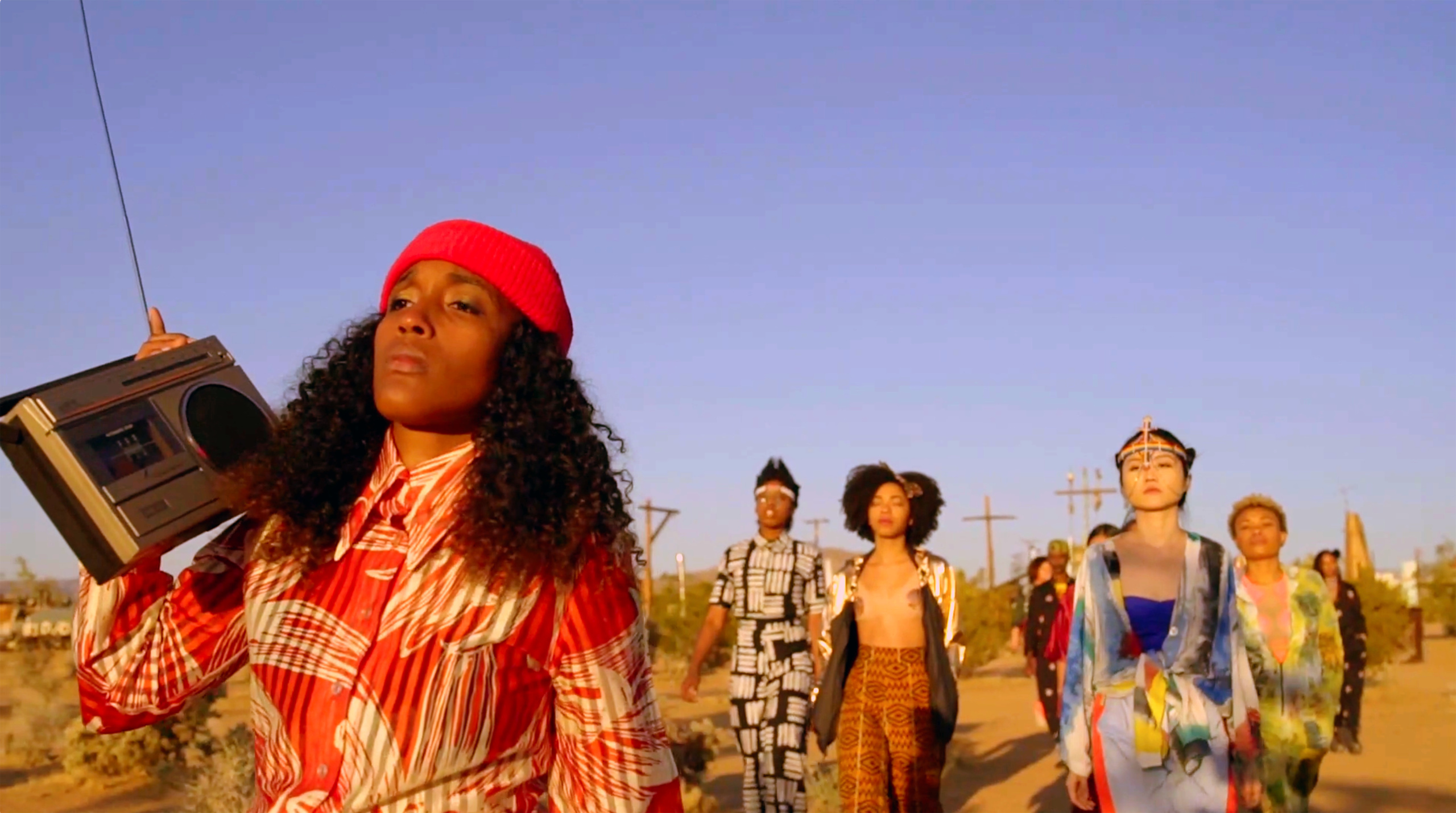
“In order to rise from its own ashes, a phoenix first must burn.”— Octavia E. Butler
Artists have long turned to the spiritual and mystical in times of crisis or amid objectionable conditions, seeking alternative understandings of reality. The Romantics responded to the upheavals of the Industrial Revolution by finding manifestations of the sublime in nature. The Symbolists rejected the rationalist worldview of the fin de siècle by retreating into dreams and myths. And in the aftermath of World War II, Abstract Expressionists plumbed the collective unconscious, exploring notions of the artist as shaman which Joseph Beuys would later fully embody. By the 1960s, with the rise of Pop and Conceptual art, spiritual expressions came to be regarded as out of step with the art of the dawning postmodern age. Feminist artists like Mary Beth Edelson and Judy Chicago learned this in the 1970s when their goddess-centered works were dismissed as essentialist and retrograde. Donna Haraway summed up this skeptical view in her 1985 essay “A Cyborg Manifesto,” declaring, “I’d rather be a cyborg than a goddess.”
The recent spate of contemporary art exhibitions devoted to the spiritual and utopian suggests the tide has turned. In 2020 alone, there were several group shows that took up such themes, including “All of Them Witches” (Jeffrey Deitch, Los Angeles), “On the Spiritual Matter of Art” (MAXXI, Rome) and “Utopian Imagination” (Ford Foundation, New York), to name a few. None, however, have considered the significance of worldbuilding through a distinctly intersectional feminist lens. Of course, the voices of women—trans and cis—have been historically silenced: we’re only now discovering the likes of Hilma af Klint and Agnes Pelton, for example, and these were white women. At a moment when global warming, COVID-19, and white male supremacy threaten our very existence, the aggregate value of such matriarchal, sibylline revelations seems incalculably relevant.
The 10 artists gathered here powerfully attest to this vitality. Exploring the age-old nexus of myth and fantasy, they traffic in magic, archetypes, time travel and metamorphosis. Like Octavia E. Butler, they regard science fiction as a force of agency and resistance, and invoke the Surrealist belief in imagination as a vehicle for liberation. The individual works chosen represent key moments in each artist’s career, exemplifying the revolutionary potential of speculative histories and futures alike. By blurring the lines between the ancient and alien, the utopian and monstrous, the real and fantastical, they offer decolonized, empathic and reparative views rooted in feminism. Together, these female-centric visions summon not just new and forgotten worlds, but ways of thinking that might actually save us.
Cauleen Smith
Cauleen Smith was raised by two social workers, and her artistic worldview was shaped early on by an ethics of care, and later by her film studies and interests in Afrofuturist feminism. These influences culminate in the kaleidoscopic installation Give It or Leave It (2018), an intergenerational portrait of three Black mystics and the utopian worlds they built for others: musician Alice Coltrane and her Santa Monica ashram; sculptor Noah Purifoy and his Outdoor Desert Art Museum; and Rebecca Cox Jackson, who founded the first Black Shaker community in the mid-19th century in Philadelphia. Amid personal and sacral objects, repurposed props, embroidered text banners, mirror balls and custom wallpaper, the installation contains projections of several of her short films comprised of new and archival footage.
The 22-minute work Sojourner (2018) is among the most striking. It follows 12 young women of color on a spiritual pilgrimage from Simon Rodia’s Watts Towers to Purifoy’s magical haven in Joshua Tree. As they move from site to site, they carry a set of orange banners emblazoned with one of Alice Coltrane’s cosmic revelations: “At dawn sit at the feet of action. At noon, be at the hand of might. At eventide, be so big that sky will learn sky.”
In the poignant final scene, the bohemian band sits by the Pacific Ocean listening to the Combahee River Collective’s 1977 Black feminist manifesto crackle forth from a transistor radio. The spirit of Sojourn-er Truth seems to move through the gathering, echoing a message of solidarity and self-determination
Morehshin Allahyari
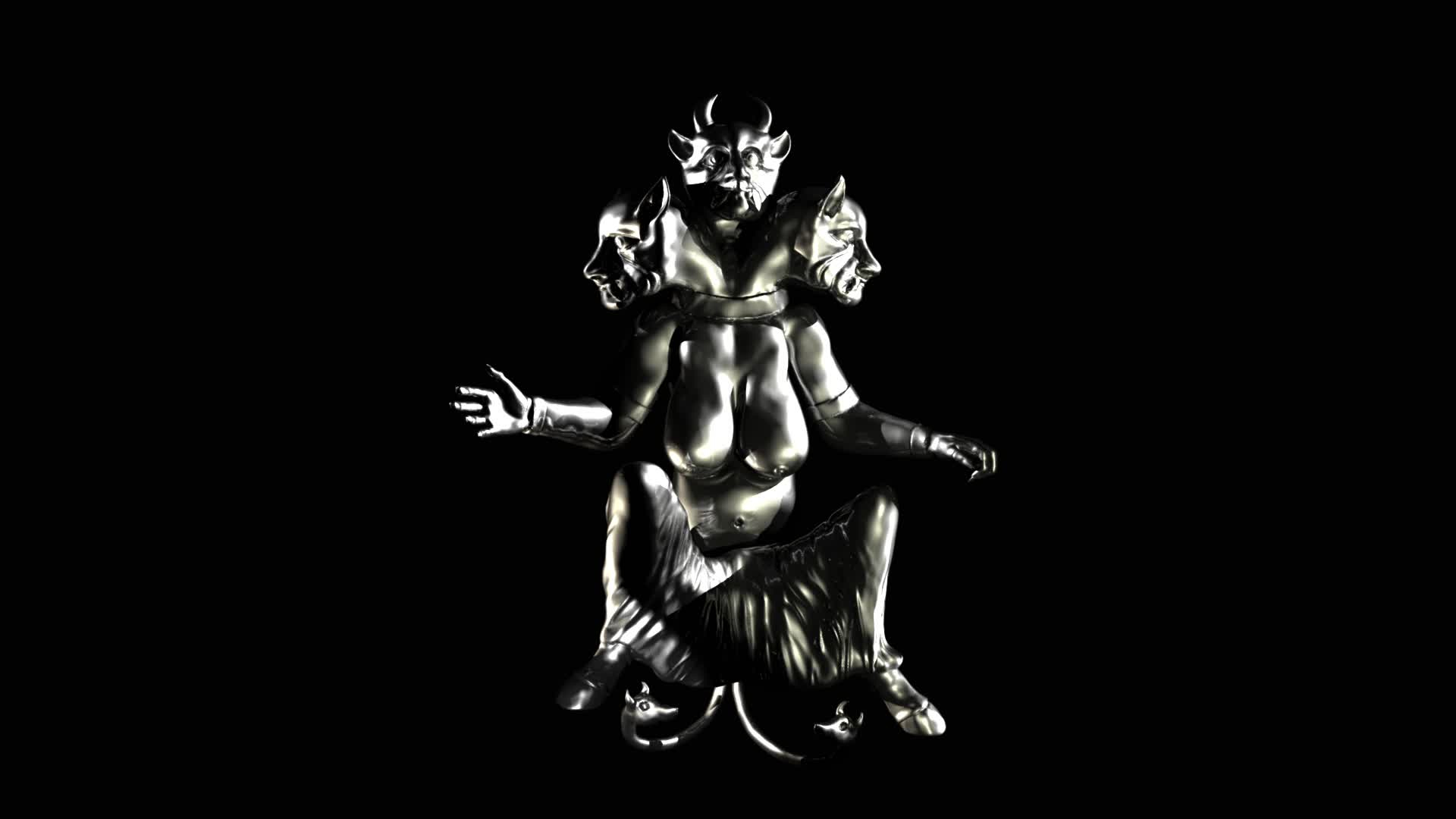
Morehshin Allahyari’s research-driven multimedia project She Who Sees the Unknown (2016–2019) conjures the ancient powers of six jinn, supernatural creatures from Islamic mythology and theology: Huma, Ya’jooj and Ma’jooj, Aisha Qandisha, the Laughing Snake and Kabous. Weaving together a universe of text, video, sculpture and performance, the project employs 21st-century methods like 3D printing and virtual reality to reactivate the mythic potential of these fearsome, shape-shifting spirits of Islamic literature and pre-Islamic legend—a far cry from the comical wish-granting genies of Disney’s Aladdin and I Dream of Jeannie. They are portals to worlds beyond the limits of Western knowledge.
Allahyari drew upon historical and personal sources alike to limn their individual legends, from the 14th- century illustrated manuscript Kitab al-Bulhan (Book of Wonders) to her grandmother’s stories of encountering jinn in the village bathhouse. Each jinn is personified as female, regardless of their traditional gender, reflecting the artist’s celebration of the monstrous feminine as a wellspring of otherness. Huma, a three-headed jinn often represented with horns and a tail, becomes in Allahyari’s multimedia retelling “She, Huma, who shatters the unjust subject.” Known for her supernatural ability to cause fever and madness in humans, Huma is reimagined as a harbinger of global warming.
All the jinn in Allahyari’s feminist epic wield their mythic, monstrous powers to engender change through revelation, functioning, in the artist’s words, as “new beings and becomings” that can “challenge and change the power structures that exist in our political and social realities.”
The Future Feminists
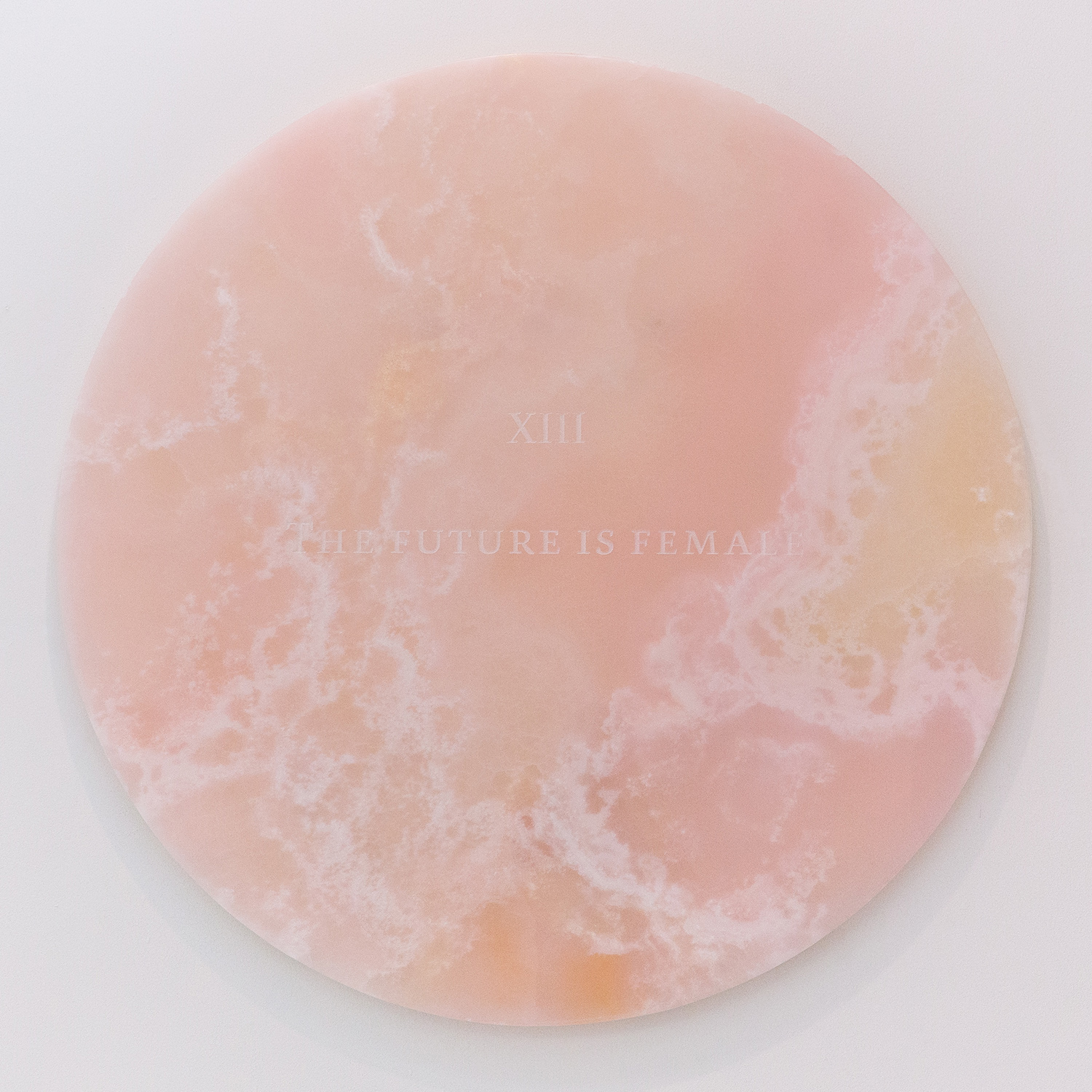
The Future Feminists created their manifesto, The 13 Tenets of Future Feminism in 2014, which they emblazoned on 13 circular slabs of rose quartz (believed to purify and open the heart, and protect against environmental pollution). The work centers on the healing potential of archetypal feminine values such as empathy, intuition and collaboration. Comprised of Anohni, Bianca and Sierra Casady (of CocoRosie), Johanna Constantine, and Kembra Pfahler (of The Voluptuous Horror of Karen Black), the group of artist-friends created the work as a series of guiding principles they believed could correct the violence and degradation patriarchy has long wreaked upon humanity and global ecosystems.
The first tenet calls upon age-old associations of women with nature, unabashedly declaring, “The Subjugation of Women and the Earth Is One and the Same.” In a similarly provocative nexus of associations, the fifth advises, “Relieve Men of Their Roles as Protectors and Predators,” reminding us that expressions of chivalry and femmephobia are two sides of the same coin. “Repattern societies to nurture the resurgence of biodiversity” is central to their vision, and embodies the “rewilding” movement. It seeks to counter what Anohni calls “the dominant misogynist, anti-indigenous manifest destiny narrative” that would colonize other planets rather than save this one. Perhaps most telling is the collective’s second tenet, “Future Feminism Requires the Participation of All People.” A clarion call for all genders—cis, trans and nonconforming—to join a future that is female, it summons the pluralist and generative nature of the feminine within each of us.
Viva Ruiz

Viva Ruiz began her Thank God for Abortion (TGFA) project in 2015, amidst the shuttering of abortion clinics and the rise of religious-right extremists intent on reversing Roe v. Wade. Her own “divinely guided” agenda sought to provoke those who presumed that no person of faith could be pro-abortion. Pushing back, she created the eponymous slogan, designed to be simultaneously joyous and unsettling. Initially printed and disseminated on T-shirts, the dissonant declaration soon spread to protest banners, posters, flags and “party looks.” Eventually, it found fruition in a giant pride parade float with theme music and choreographed dance. “My practice is basically rage and ecstasy,” she explains. “There’s a lot of screaming and a lot of dancing.”
This radical insistence on celebration foregrounds the global intersectional nature of abortion politics and unshackles the procedure from shame. The child of devoutly Catholic Ecuadorian immigrants, Ruiz is both subversive and sincere when she repurposes church rituals, symbols and liturgical garments in TGFA exhibitions and performances, like the white dove that interlaces her slogan and the gold cross she wears around her neck. She sees her reclamation as a necessary act in a war against femicide. Until there is a world where abortion is free and accessible to all, Ruiz will carry forth her TGFA message, dressed all in white behind a customized riot shield, ready to do God’s work.
Tuesday Smillie

In her multimedia body of work Reflecting Light into The Unshadow (2012–2018), Tuesday Smillie has created a series of banners, textile collages, prints and watercolor paintings inspired by Ursula K. Le Guin’s groundbreaking 1969 sci-fi novel The Left Hand of Darkness.
Smillie’s homage is a celebration of both the book’s proto-transfeminist leanings and the author’s acknowledgement of its shortcomings. Le Guin’s admission in two subsequent articles that her book’s use of male pronouns to connote gender neutrality and its simplistic vision of a post racial society were problematic, an instance of autocritique rare among novelists. For Smillie, this willingness to model an evolution in one’s thinking was as radical as imagining a warless, sexually liberated, utopian future of androgynous beings.
The artist’s replication in watercolor of the covers of 15 different editions of the book traces another kind of evolution, revealing the text’s changing and varied significance across time and culture. Working from used copies, her meticulous renderings of these reprints capture every stain, scratch and blemish with the same care that she devotes to the fonts and illustrations. The artist reminds us that in such flaws, like those of the text itself, one can glean revelations as meaningful as those intended by design—if we’re willing to look.
Saya Woolfalk

When in 2009 the multimedia artist Saya Woolfalk first invented the Empathics, her fictional female race of hybrid beings who merged their human forms with those of plants, she imagined them populating an idyllic world she had created in an earlier project, No Place (2006–2009). The latter, like most of her work, consisted of video, dance-based performance and figural sculptures in fantastic botanical costumes. A speculative universe of harmonious abundance, No Place was inspired by the syncretic culture of Brazil, with its colorful spectacles like the festival of Bumba Meu Boi.
When Woolfalk concocted Lessons from the Institute of Empathy (2012), an installation featuring ethnographic displays, she imagined it a research institute where the Empathics could figure out how to patent their chimeric powers and share them with others. By the time she came up with ChimaTEK, a mock-corporation that marketed related products, in 2014, her work had begun to explore the thornier implications of commerce and technology: what monetizing her utopian vision of post-racial, post-gender bliss would look like. The infusion of her psychedelic folk aesthetic with augmented reality, virtual reality and 3D animation at this moment in her practice no doubt informed these critical thoughts.
The 3-minute video Life Products by ChimaTEK (2014) crystallizes these concerns, taking the form of an advertisement for a hybridizing machine. Fueled by luminescent rocks, the fantastical instrument enables users to erase and remix their identities, all while expanding their consciousness. In the real-world context of capitalist exploitation, Woolfalk’s Empathics suddenly become purveyors of engineered identity, their halcyon promise of transhumanism now as dystopian as it once was curative. It’s a sibylline message with a silver lining, because Woolfalk has not given up on building a better future through empathy, and neither should we.
Chitra Ganesh
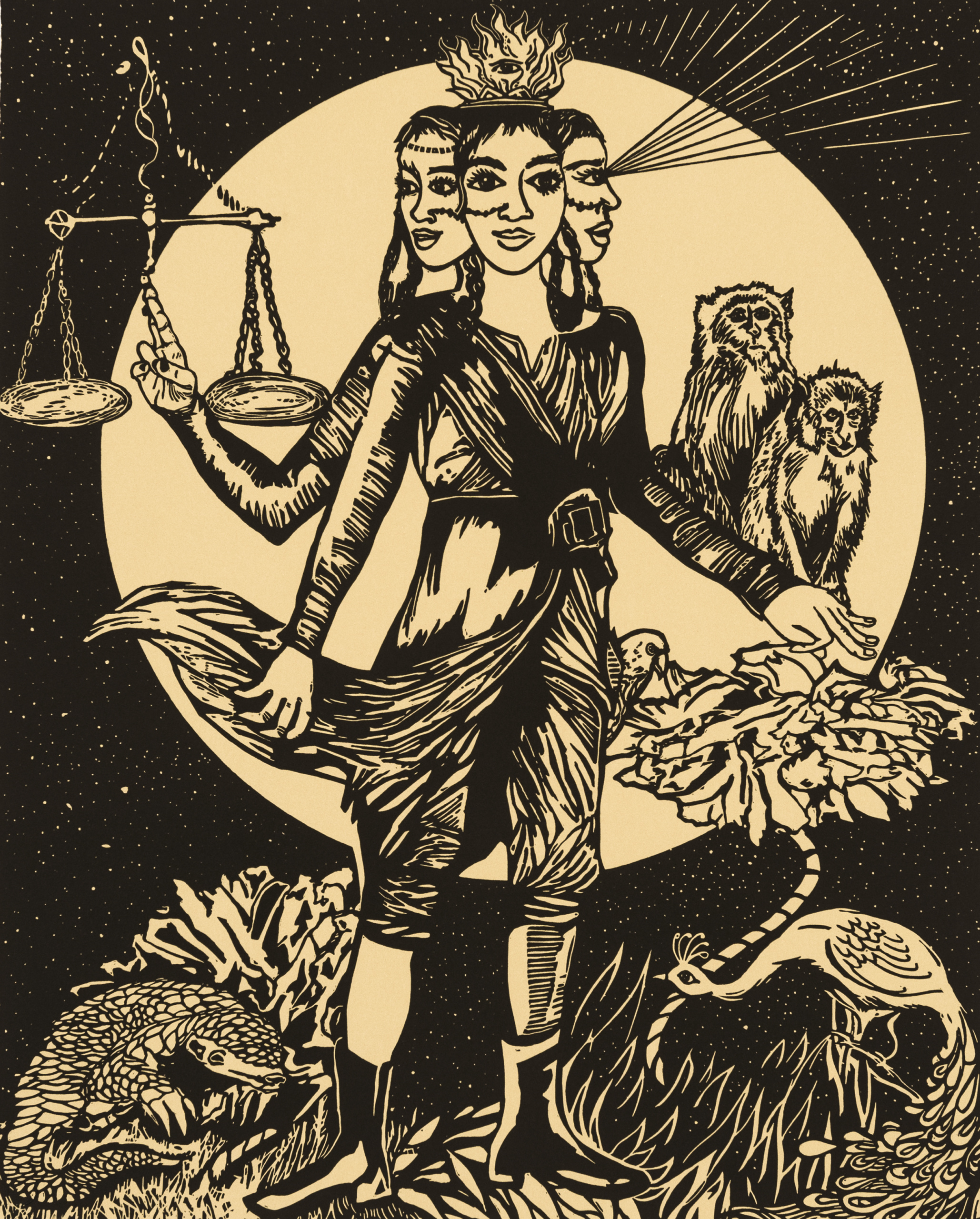
Charlotte Perkins Gilman’s 1915 Herland is often called the first feminist sci-fi novel, but in fact it appeared 10 years after Rokeya Sakhawat Hossain’s utopian novella Sultana’s Dream. Both imagine matriarchal societies where women are in charge, but Hossain’s vision of Ladyland—where men are cordoned off from public life and women instead rule—was a much riskier act of imagination, given that she was a Bengali Muslim woman, born and raised in the segregated system of purdah.
Chitra Ganesh’s visual homage to Hossain’s seminal text, an eponymously titled series of large- scale black-and-white linocut prints made during 2018–2019, embodies this subversive revolutionary spirit. Bringing to life the book’s vibrant imagery of female empowerment and eco futurism, Ganesh showcases in particular Hossain’s embrace of science and education as tools of liberation and prosperity. Individual prints like Oracle in the Baoli Water Storage and Sultana University depict flying cars, miraculous botany and solar-powered energy.
As a queer artist inspired by Hindu mythology, Indian comic books, Bollywood and Qawwali music, among other sources, Ganesh mines the euphoric and prophetic potential of Hossain’s Ladyland for a contemporary audience. Like the female deities, superheroes and warriors that populate her own futuristic narratives, her illustrations are full of political subtext and mystical reverie. Speaking of “the enduring relevance of feminist utopian imaginaries” to create a more just world, she holds fast to the belief at the heart of Sultana’s Dream—that women can save the day.
Vanessa German

Vanessa German’s Power Figures are talisman-like assemblages that invoke the tradition of nkisi, spirit-invested objects which were significant in the art and material culture of the central African kingdom of Kongo. Like nkisi, German’s Power Figures serve as magical receptacles for the spirits of ancestors, though she devotes many to the living as well as the dead. German creates these lavishly embellished works to honor and protect victims of racism—from tennis legends Serena and Venus Williams to those murdered by the police. Blackness and queerness are the deities she serves in these figural works, which she fashions from bric-a-brac—fake flowers, cast-off sneakers, keys, fabric, broken instruments and cutlery—and always tops with a Black head.
The monumental work Laquisha Washington Crosses the Day Aware (2018) turns Emanuel Gottlieb Leutz’s iconic 1851 painting Washington Crosses the Delaware into a tableau of a parade celebrating the feats of ordinary Black Americans. Black-masked figures in colonial costumes, made from Ankara cloth, crowd a 17-foot long boat festooned with quilts and sequined fabric. Under the command of Laquisha, who stands taller than the rest and cradles a baby beneath a bib of cotton balls, the figures who row the boat use crutches for paddles. Alluding to the legacy of slavery on which the myth of liberty and justice for all is paradoxically founded, German’s heroic figures also embody the healing powers of love and art, which allow her to conjure, as she told an interviewer in 2019, “the Black Body into freedom.”
Juliana Huxtable
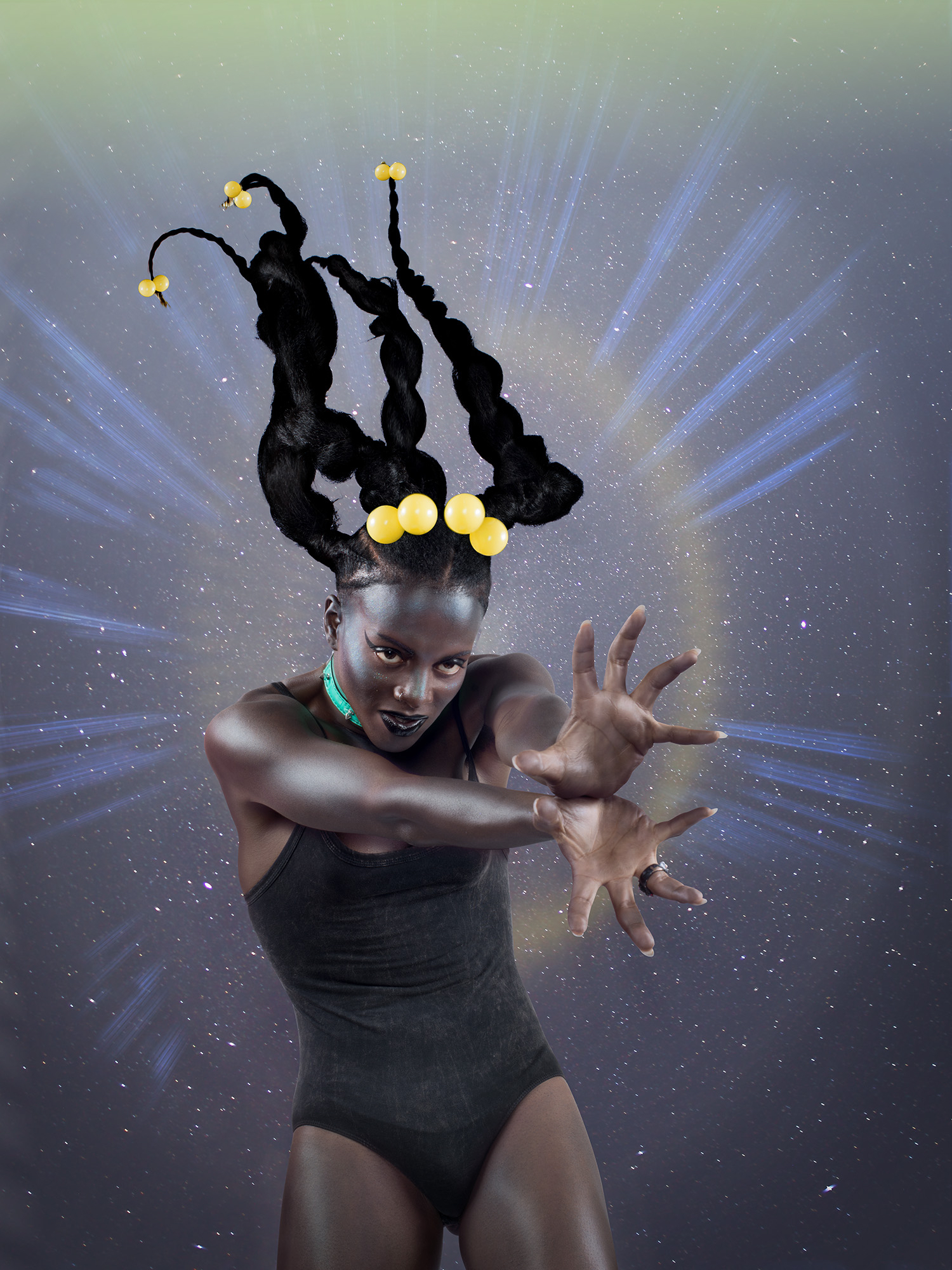
Like the many roles Juliana Huxtable plays IRL—DJ, artist, writer, fashion muse—the selfportraits she creates in her photographic work express a relationship to identity that is expansive and fluid. Her formative series Universal Crop Tops for All the Self Canonized Saints of Becoming (2015) marked the beginning of her playful manipulations of her body in an anarchic exploration of desire. The human-alien creatures she transforms herself into offer an other-worldly vision of self-presentation that reflects her identity as a Black trans woman. Inspired by the symbolism of Nuwaubianism, a cult that posits that Black people are divine and white people the soulless spawn of alien reptiles, her sci-fi-styled avatars are playful nods to the power of fantasy to transcend trauma.
Untitled in the Rage (Nibiru Cataclysm) features the artist nude but for a lizard-like skin of turquoise-green paint, an ankle bracelet and a cascade of long yellow braids. Sitting on her knees in three-quarter view that emphasizes her backside as well as her contemplative face, she inhabits a painterly landscape marked by a prominent full moon. The super heroine of Untitled (Lil’ Marvel) crystallizes the artist’s embodiment of Black femme resistance. Standing in a black leotard against a starry night sky, yellow-ball-tied braids flying above her head, she summons her supernatural gifts with outstretched palms to become all that she is: “cyborg, cunt, priestess, witch, Nuwaubian princess,” as she put it in 2015, when her work was included in the New Museum Triennial.
Allyson Mitchell
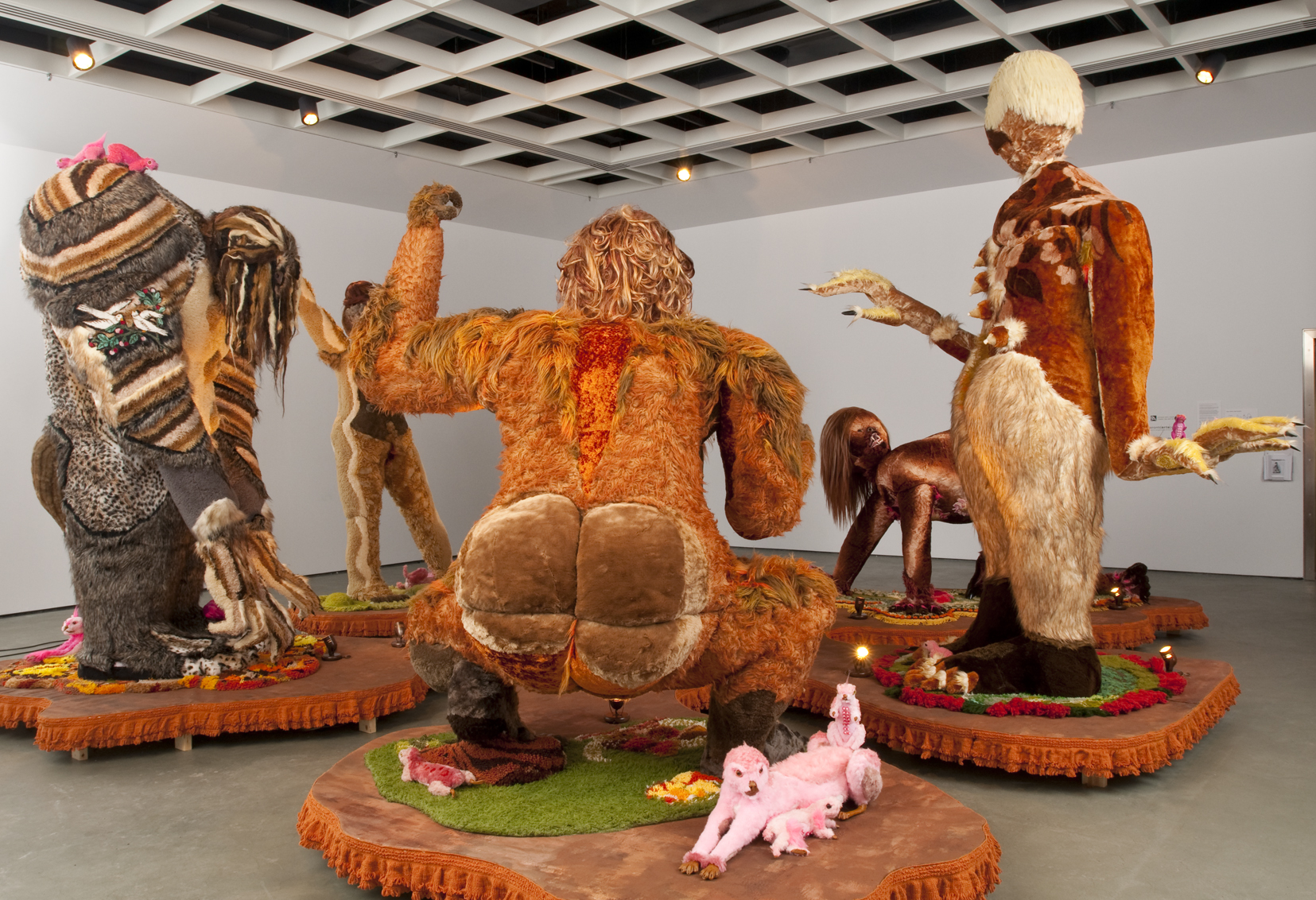
Allyson Mitchell is a lesbian filmmaker and artist, with a maximalist sensibility that finds its truest expression in large-scale installations like Ladies Sasquatch (2006–2010). The work, which reminds us that utopias are ultimately communal and separatist by nature, imagines a world of female bigfoots. Playful yet subversive, it features six giant figures made of fake fur, taxidermy supplies, 1970s-era textiles and abandoned craft projects salvaged from thrift stores.
The six giantesses, some of whom bend to flaunt genital swellings, while others stand tall to flaunt their physical prowess, gather ritualistically around a lean- to fire lay. The presence of small, hot-pink she-beasts, a soundscape collage of music and nature sounds, and theatrical lighting that illuminates the otherwise darkened forest complete the bewitching scene.
As with much of her work, Mitchell confronts stereotypes here, merging caricatures of the big, fat, hairy dyke with B-movie depictions of Sasquatch. The latter’s spiritual roots in ancient indigenous folklore lurks within their menacing faces, fangs and claws, a vision of decolonized queer bodies. Fearsome and untamed, her outsized monsters are above all manifestations of what the artist has deemed “Deep Lez,” a form of radical dyke politics she sums up as “part quilting bee, part public-relations campaign, and part Molotov cocktail.”
Craving more culture? Sign up to receive the Cultured newsletter, a biweekly guide to what’s new and what’s next in art, architecture, design and more.










 in your life?
in your life?

